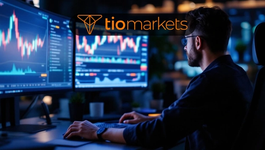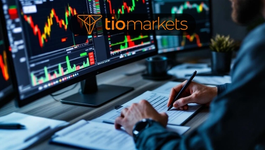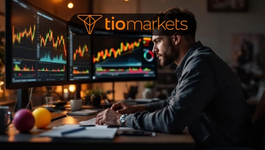What are Futures?
BY TIOmarkets
|May 16, 2024Futures are financial contracts that allow individuals and institutions to buy or sell certain assets at a predetermined price, on a specified future date. They provide a means for market participants to hedge against price fluctuations or speculate on price movements. Understanding the concept of futures is crucial for anyone looking to engage in trading or investing.
Understanding the Concept of Futures
Futures can be defined as standardized agreements between two parties to buy or sell commodities, financial instruments, or other assets at a future date. These contracts are traded on futures exchanges, which act as intermediaries, facilitating the buying and selling process.
Futures have a long history and have been used for centuries to manage risks and ensure the availability of essential goods. In the past, farmers used futures contracts to lock in prices for their crops, while merchants used them to secure future deliveries.
Definition of Futures
A futures contract is a legally binding agreement between a buyer and a seller to exchange a specific quantity of an underlying asset at a predetermined price, on a specified date in the future. The underlying asset can be a commodity like oil, gold, or wheat, or a financial instrument like stocks, bonds, or currencies.
For example, let's say an investor enters into a futures contract to buy 100 barrels of oil at $60 a barrel, with a delivery date three months from now. If the price of oil goes up to $70 a barrel by the time of delivery, the buyer will benefit from the lower pre-determined price, while the seller will have to deliver the oil at a lower price than the current market value.
The History of Futures
The concept of futures trading can be traced back to ancient times when traders in Babylonia used to sign contracts to deliver goods in the future. However, the modern futures market as we know it today began to take shape in the 19th century when organized exchanges such as the Chicago Board of Trade (CBOT) were established.
The CBOT, founded in 1848, played a significant role in the development of futures contracts for agricultural commodities like corn, wheat, and soybeans. As economies evolved and financial markets expanded, futures contracts became popular for a broader range of assets, including financial instruments and even intangible assets like stock market indexes.
The Mechanics of Futures Trading
To understand how futures contracts work, it's essential to grasp some key concepts. First and foremost, futures contracts are standardized in terms of contract size, delivery date, and quality of the underlying asset. This standardization allows for liquidity and ease of trading.
When entering into a futures contract, the buyer agrees to take delivery of the asset on a specific date in the future, while the seller agrees to provide the asset. However, it's important to note that most futures contracts are not physically settled but are instead cash-settled, meaning the profit or loss is settled in cash upon contract expiration.
How Futures Contracts Work
When traders buy or sell futures contracts, they are essentially speculating on the future price direction of the underlying asset. If a trader believes the price will go up, they buy a futures contract (going long). If they believe the price will go down, they sell a futures contract (going short).
As the market price of the underlying asset fluctuates, so does the value of the futures contract. Traders can enter or exit positions at any time by offsetting their contracts, either by buying/selling an opposite contract or by entering into an offsetting transaction. This allows for flexibility and the possibility of profiting from both rising and falling markets.
The Role of Futures Exchanges
Futures contracts are traded on organized exchanges, such as the Chicago Mercantile Exchange (CME), Intercontinental Exchange (ICE), and others. These exchanges provide a central marketplace where buyers and sellers can come together to trade standardized futures contracts. They also ensure transparency, liquidity, price discovery, and the enforcement of market rules and regulations.
On the futures exchanges, buyers and sellers can place orders to buy or sell futures contracts through their brokers. These orders are matched electronically, and trades are executed at the prevailing market price. The exchanges also provide clearing and settlement services, ensuring the financial integrity of the transactions.
Types of Futures
There are various types of futures contracts available for trading, depending on the underlying asset class. The two main categories are commodity futures and financial futures.
Commodity Futures
Commodity futures contracts involve the buying or selling of physical commodities like agricultural products (corn, wheat, soybeans), energy products (crude oil, natural gas), metals (gold, silver), and others. These contracts provide a means for producers, consumers, and traders to hedge against price volatility and manage risks associated with the underlying commodities.
For example, a corn farmer may enter into a futures contract to sell a certain quantity of corn at a predetermined price several months ahead. This allows the farmer to lock in a price and protect against potential declines in corn prices due to factors like weather conditions or market fluctuations.
Financial Futures
Financial futures contracts are based on financial instruments like stocks, bonds, currencies, and interest rates. These contracts allow investors to speculate on the price movements of these assets or hedge against potential financial risks.
For instance, an investor may buy a futures contract on the S&P 500 index, which represents a basket of stocks, to gain exposure to the overall performance of the stock market. This provides an efficient way to diversify and manage risk compared to investing individually in multiple stocks.
Benefits and Risks of Futures Trading
Futures trading offers several advantages for investors and traders, but it also comes with its fair share of risks and potential drawbacks.
Advantages of Investing in Futures
One of the key benefits of trading futures is the potential for significant leverage. Since futures contracts require only a fraction of the total contract value as margin, traders can control a more substantial position. This allows them to amplify potential profits. However, leverage also increases the risk of losses.
Another advantage is the ability to profit from both rising and falling markets. With futures, traders can take both long (buy) and short (sell) positions, enabling them to benefit from upward or downward price movements.
Futures markets are highly liquid, meaning there is a constant flow of buyers and sellers. This liquidity ensures that traders can enter and exit positions quickly and at reasonable prices. Additionally, futures contracts are standardized, making them easily tradable.
Potential Drawbacks and Risks
Despite their advantages, futures trading comes with potential risks. One of the main risks is the high volatility in futures markets. Prices can move rapidly, resulting in significant gains or losses. Traders need to carefully manage their positions and use risk management tools like stop-loss orders.
Another risk is the possibility of contract expiration. Traders who hold positions until contract expiration must either physically settle the contract or roll it over into a new contract with a different expiration date. This process involves additional costs and complexities.
Key Terminology in Futures Trading
Understanding key terminology is essential when trading futures. Here are some important terms to know:
Important Terms to Know
- Margin: The amount of money required to open and maintain a futures position.
- Liquidity: The ease at which a futures contract can be bought or sold without significantly impacting its price.
- Long Position: Buying a futures contract with the expectation that its price will rise.
- Short Position: Selling a futures contract with the expectation that its price will fall.
- Contract Expiration: The date at which a futures contract expires, requiring either physical delivery or settlement in cash.
Strategies for Futures Trading
There are various strategies that traders can employ when trading futures, depending on their risk tolerance, goals, and market conditions.
Hedging with Futures
Hedging with futures involves taking a position in a futures contract to offset potential losses in an existing investment position. For example, a farmer who expects to harvest a crop several months from now can sell futures contracts to lock in a price and protect against potential price declines.
This strategy helps mitigate risk by providing a guaranteed selling or buying price, reducing the impact of market volatility on the overall portfolio value.
Speculating with Futures
Speculating with futures involves taking positions with the intention of profiting from anticipated price movements. Traders who have analyzed market trends and believe that an asset's price will rise can buy futures contracts and sell them later at a higher price.
Speculating with futures requires careful analysis, risk management, and staying updated with market news and events that could impact prices.
Conclusion
In conclusion, futures are financial contracts that provide traders and investors with opportunities to hedge against price fluctuations or speculate on future price movements. Understanding the concept and mechanics of futures trading is essential for anyone considering participating in this dynamic market. If approached with careful analysis, risk management, and a solid understanding of the underlying assets, futures trading can offer potential benefits and opportunities for financial growth.
Start Trading Futures with TIOMarkets
Ready to put your knowledge of futures into action? Join TIOMarkets, a top-rated forex broker, and step into the world of online trading with confidence. With over 170,000 accounts opened across more than 170 countries, TIOMarkets offers you the ability to trade over 300 instruments across 5 markets, including Forex, indices, stocks, commodities, and futures, all with low fees. Enhance your trading skills with our comprehensive suite of educational resources and step-by-step guides. Take the first step towards your trading journey and Create a Trading Account today!

Risk disclaimer: CFDs are complex instruments and come with a high risk of losing money rapidly due to leverage. You should consider whether you understand how CFDs work and whether you can afford to take the high risk of losing your money. Never deposit more than you are prepared to lose. Professional client’s losses can exceed their deposit. Please see our risk warning policy and seek independent professional advice if you do not fully understand. This information is not directed or intended for distribution to or use by residents of certain countries/jurisdictions including, but not limited to, USA & OFAC. The Company holds the right to alter the aforementioned list of countries at its own discretion.
Join us on social media

Behind every blog post lies the combined experience of the people working at TIOmarkets. We are a team of dedicated industry professionals and financial markets enthusiasts committed to providing you with trading education and financial markets commentary. Our goal is to help empower you with the knowledge you need to trade in the markets effectively.
Related Posts





